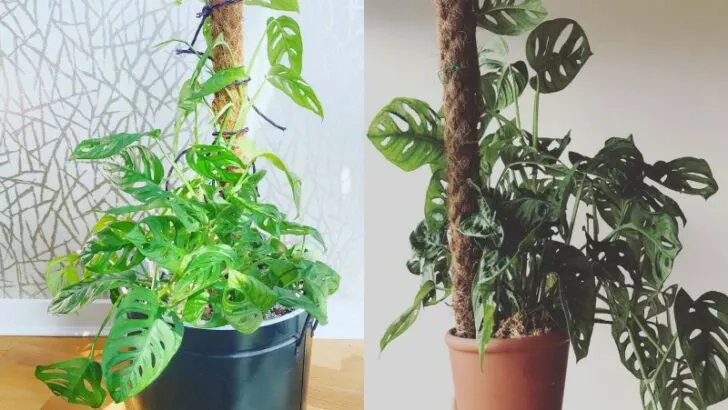Reviewed by: Emelyn Furio
Are you looking for a Monstera adansonii care guide? If so, you came to the right place.
Find a downloadable Monstera adansonii care guide at the end of this article.
Monstera adansonii Care
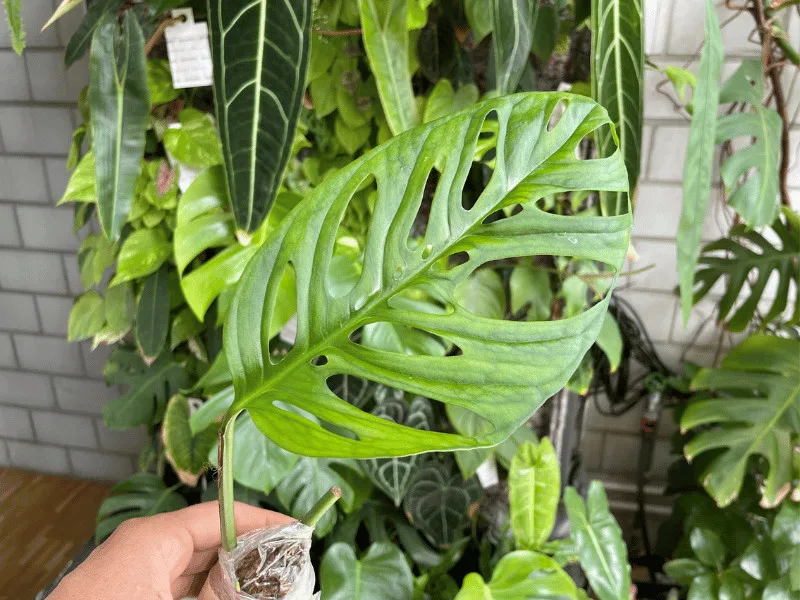
The Monstera adansonii grows best in a well-draining Aroid mix using bark, perlite, peat moss, and charcoal. Keep your in and humidity above 60%. When , ensure that the of your Adansonii remains slightly moist and about once a week. The ideal temperature range is between 64 – 81 °F (18 to 27 °C). Use well-balanced fertilizer at half-strength with an NPK ratio of 20-20-20.
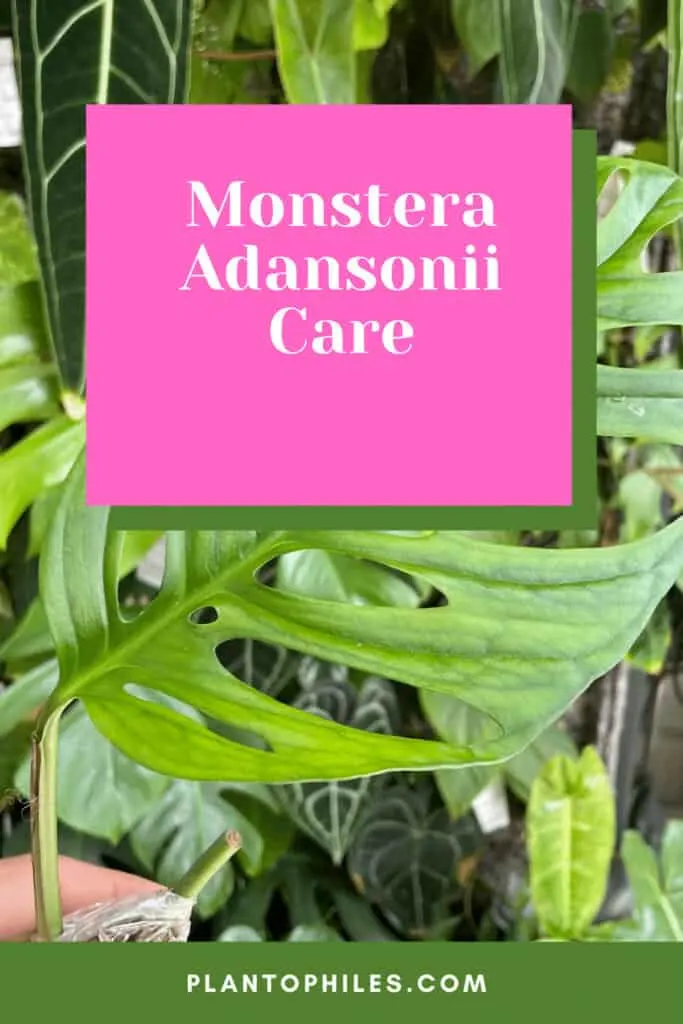
Monstera adansonii Plant
Monstera adansonii is a tropical plant with fenestrated leaves.
Known for its unique appearance, is also called the Swiss Cheese Vine, Monstera Monkey Mask, or Monstera friedrichsthalii.
It belongs to the Aroid or Araceae family (Arum family), according to the University of Michigan. Similar to Monstera deliciosa, this plant is a climber.
Juvenile leaves have no perforations. The holes and leaves will grow larger as the plant climbs and matures.
Monstera adansonii Care Takeaways
| Species | Monstera adansonii |
| Synonyms | Adanson's monstera, Swiss cheese vine, Five holes plant |
| Family | Araceae |
| Genus | Monstera |
| Growth | Climbing, vining |
| Height | 8 feet |
| Width | 2 feet |
| Soil | Chunky aroid soil |
| Watering | Water every 5 to 7 days |
| Light | Bright indirect |
| Temperature | 64 to 81°F |
| Humidity | 60-80% |
| Fertilizer | Fertilize 2 times per month |
| Propagation | Stem cuttings, seeds |
Table of Contents
Swiss Cheese Vine Care Video
Monstera adansonii soil
The best potting medium for a Monstera adansonii is an Aroid mix with orchid bark, perlite, peat moss, and charcoal.
You can also grow it in hydroponics. I have several plants in leca in an ebb and flow system that grow well.
As Monstera adansonii is an epiphyte, it needs a well-draining growing medium or develops root rot.
The ideal pH for the potting soil is 5.5 to 7.0.
One of the most important aspects is drainage. This plant thrives in a pot with large draining holes on the bottom.
I also grow multiple adansonii in a soilless medium. I use Leca and Lechuza pon. These plants are epiphytes and strive in these mediums because they allow oxygen to flow freely to the roots.
Monstera adansonii light
Monstera adansonii prefers bright, indirect light. Bright light is between 10k – 20k lux or 2k – 5k foot candles.
Considering the natural habitat of a Monstera adansonii, it grows in the sparsely lit jungles of South and Central America; these plants need bright indirect light.
Place it a few feet away from a well-lit window to give your Swiss Cheese Vine species the best chance. East or west-facing windows are a great choice.
The light plants receive indoors is much weaker than natural sunlight. Natural sunlight is measured at approx. 10k foot candles or 100k lux.
In winter, I supplement my Monstera adansonii with a grow light. I use it for all seasons to accelerate the growth of my Adansonii.
If you are interested in a grow light, you can look at Amazon. The one I use is the Roleadro, and it has 75w.
What I like about it is that it is very affordable yet powerful and has a natural light variant.
I do not like to have this typical pinkish-grown light aura in my living room.
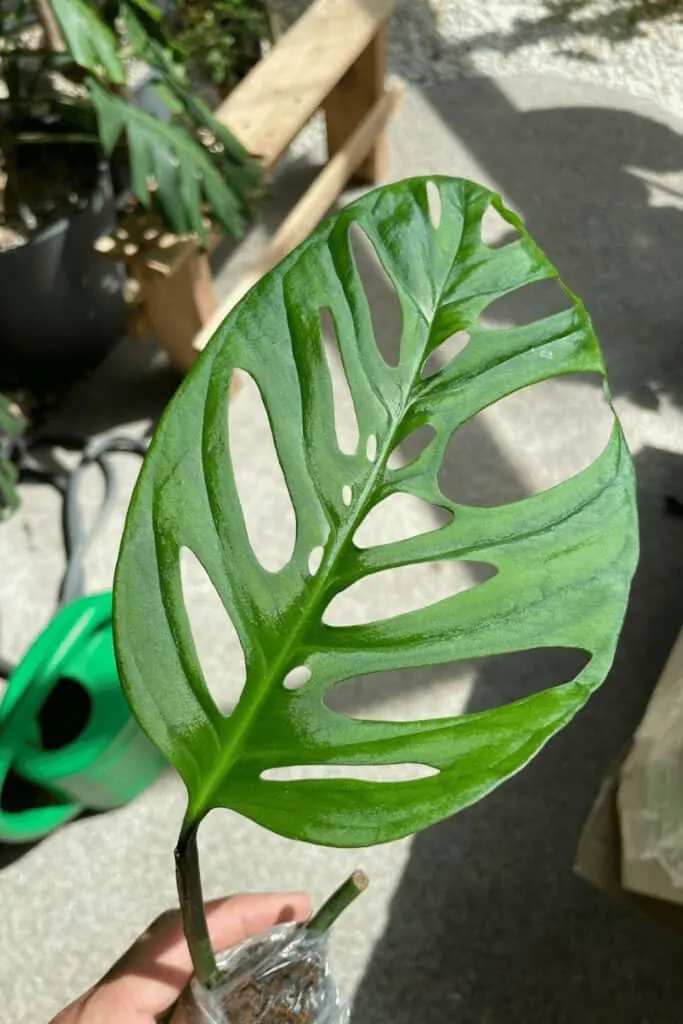
Monstera adansonii Watering
Water the Swiss cheese vine about once a week.
Taking care of the Monstera adansonii vine is quite easy, except for their water requirements. They can be somewhat picky in this area.
Water regularly. The soil needs to be slightly moist but not soggy.
When you water, water thoroughly to mimic conditions in the jungle. A thorough watering will also flush away the salt that is building up.
The reason salts build up is because of fertilizer or hard water.
Salt buildup can cover the roots. It is visible as a coating or a white crust. Too much salt will prevent the roots from taking in nutrients. Therefore, it is essential to flush your plants frequently. This process is called leaching.
Overwatering can be a common issue, so ensure to provide apt drainage through holes in the bottom of your pot, according to the University of Florida.
Watering during the growing season
The Swiss Cheese Vine must be watered more in spring and summer as it grows faster during the growing season. The increased warmth leads to more growth. Water it every 3-5 days, depending on the soil humidity.
Watering in winter
Reduce watering in winter because Monstera adansonii grows slower in wintertime. Too much water will also lead to root rot faster in combination with cold temperatures.
Read more about how often to water Monstera adansonii in my full guide.
Temperature
Keeping this plant’s environment at the correct temperature is not important. They prefer rooms kept at a temperature between 64 – 81 °F (18 to 27 °C).
Anything less than 64°F (18°C) will tremendously slow plant growth. Below this temperature, you risk your adansonii wilting and dying from the cold.
It can take short periods of cold temperatures. Longer exposures will not just be tolerated by a little dieback but may result in the death of your leafy friend.
To shield your plant from cold temperatures, keep it away from windows and cold drafts. You can also use a heat mat underneath the pot in winter or put it in an enclosed plastic container or terrarium.
I sometimes use bubble wrap around the planter to warm the soil and roots.
Swiss Cheese Vine Humidity
A humidity level of 60-90% generally works best in experience. Aerial roots will grow readily; the plant can easily attach to moss poles and other supporting structures. Such high humidity is achieved in greenhouses or terrariums.
The humidity requirement of your Monstera adansonii is higher than that of other houseplants, but it is not a must. They are found in Central and South America in areas with high moisture.
But you can keep this plant in 60% or 40% humidity. You will have to water more.
Misting plants is not a good idea as the added humidity is short-lived, and wet leaves can lead to fungi problems.
Humidity can be increased using a humidifier; a pot below the plant with pebbles or stones filled with water can increase humidity.
A humidifier is unnecessary to keep your Monstera adansonii plant alive but can increase its health and growth.
I use a Levoit humidifier, and my adansoniis love it.
It’s great to see how the air roots attach to a moss pole much better and how the leaves get bigger and bigger on my Monstera Adansonii.
Read my full review of the best humidifiers for houseplants.
I can conclude that the Monkey Mask generally loves humidity and will thank it with bigger, stronger leaves and growth.
Fertilizer
A well-balanced fertilizer at half-strength using an NPK ratio of 20-20-20 is best for Monstera plants.
Fertilize every two weeks in spring and summer and once a month in autumn and winter.
Use either a liquid fertilizer or a slow-release fertilizer.
Adding fertilizer is important as the nutrients in a pot are limited. Monstera adansonii grows quickly and cannot produce enough chlorophyll without fertilizer.
Without the addition of fertilizers, the leaves tend to become yellow.
Yellow leaves can be a sign that your cheese vine lacks nutrients.
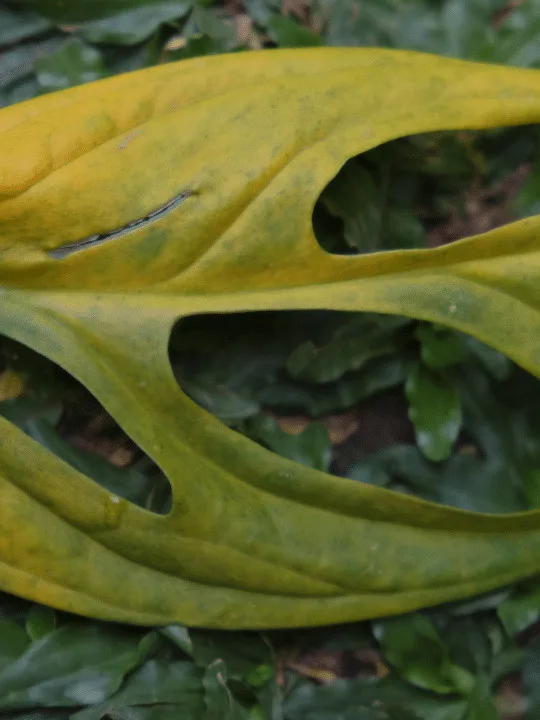
Do not fertilize when you have just repotted your Monkey Mask or your plant has a weak root system. This is when your roots are weak and could be burnt by fertilizer.
You can also avoid overfertilization by using only 1/2 or 1/3 of the recommended strength indicated on the fertilizer prescription.
After fertilizing the plant, flush the soil to avoid pockets of high fertilizer concentration in the potting mix.
Monstera adansonii propagation
You can propagate the Swiss Cheese Vine using stem cuttings or seeds. The cuttings can be propagated in water, soil, sphagnum moss, or perlite.
Use a piece of the stem and at least one node. Nodes are these brown or whiteish knobby sections just below where leaves emerge and branch off the stem.
To propagate Monstera adansonii, do the following:
- Prepare a knife or scissors by disinfecting the blade using an open flame or rubbing alcohol
- Make a clean cut just below a node on the main stem
- Ensure your cutting has at least one node (2-3 nodes and leaves are best)
- Let the cutting callous over for 15 minutes
- Put the cutting in water or medium and ensure it gets high humidity, warmth, and bright indirect light
- After 2-3 weeks, roots start growing
- Transfer your cutting into your preferred medium once the roots are 2-3 inches long (5.0-7.5cm)
Here is a detailed step-by-step guide to propagate the Swiss Cheese Vine.
Swiss Cheese Vine Water Propagation
One of the most common ways plant owners propagate their Swiss Cheese Vine plants is to root them in water. To begin this process, cut a piece of the vine by taking a stem cutting from the mature plant.
Be sure that there are at least one or two nodes included. This is where the leaves begin to develop from the stem.
Once you have finished making the correct cut from the vine, fill a bowl with water.
Place the cut vine and the filled bowl into a spot where indirect sunlight is present. Replace the water every few days until roots begin to form. This typically takes place within a few weeks.
Continue to monitor the new plant, moving them to the soil once the root is strong enough to support itself.
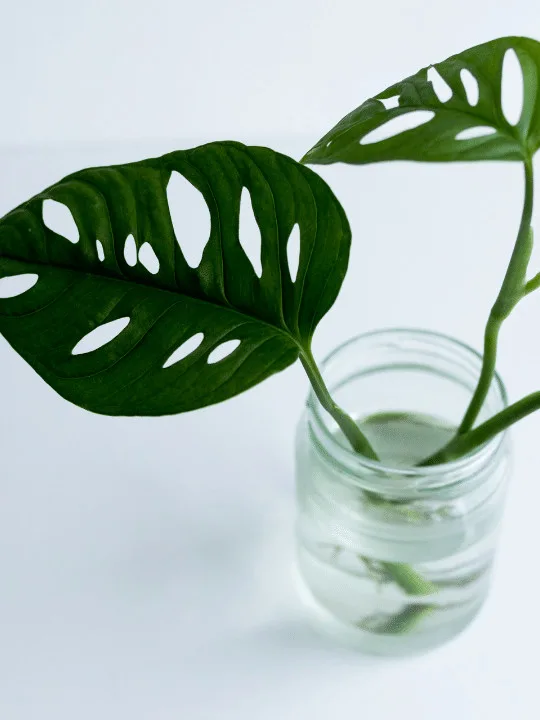
Monstera adansonii Soil Propagation
Although not the most widely accepted strategy, you can skip the involvement of water rooting. As before, cut a piece off the vine where at least one or more nodes are present.
This is where the method begins to differ. Instead of placing the cuttings into a water bowl, dip them until moist.
Once this is done, fill a small pot with soil that has been properly hydrating and stick the cutting in about a half-inch underneath the top layer of soil.
Set this pot in an area with indirect sunlight and wait for the root to grow. As with the first propagation strategy, this will take a few weeks.
Growth
After being freshly propagated, these plants typically take about 2 to 3 weeks to grow before being placed in a .
You can differentiate the new and old growth through the physical appearance of the leaves.
Newer leaves on the cuttings will have fewer holes than those with more developed ones.
After taking a cutting, the new leaves will also be smaller than the older ones, and it is not uncommon that the cutting will revert to an immature growth stage with no or very few holes per .
Young plants often have no holes in the leaves. The leaves will emerge as the Adansonii matures. When new leaves emerge, they will be fresh, bright green, and darken to dark green when maturing.
The is a that is either climbing or trailing.
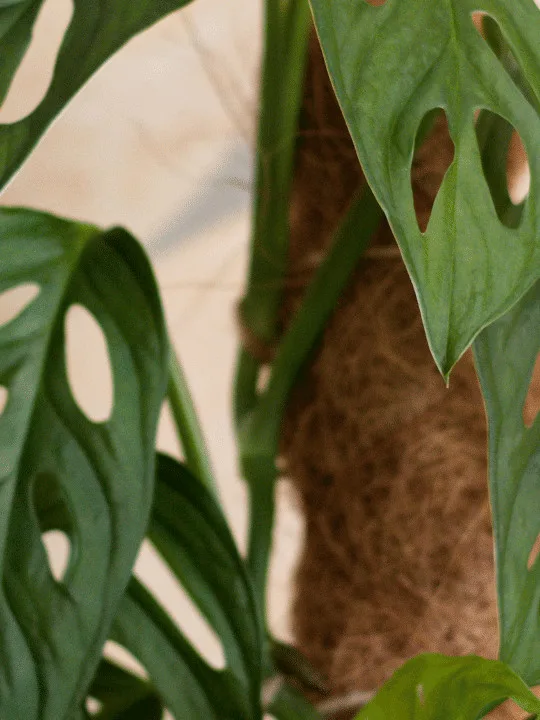
If you want your adansonii to climb, you can put it into a .
When the is climbing, it will produce bigger and bigger leaves. Provide it with a moss pole that you stick into the grow pot, and it will start to climb and attach its air roots to the pole.
An is a part that grows out of the plant’s stem and is above ground. It is meant to attach to other objects and stabilize the .
In its natural habitat, it climbs the stems and branches of other plants. As an epiphyte, these plants can grow on other plants or a as houseplants.
Can you grow Monstera adansonii in Water?
It is possible to grow Monstera adansonii in just water. I left a few of my propagations in water indefinitely, and they are doing well. The most important thing is to exchange the water every 5-7 days. In addition you need to add a balanced liquid fertilizer every 2-4 weeks. The water itself contains little nutrients.
Potting
This does best when repotted every two years, at the very most. Otherwise, Monstera adansonii becomes pot or root bound. Botanists recommend placing your Monstera adansonii in a larger pot yearly to ensure it remains healthy.
But ensure that the pot-to-plant or soil-to-plant ratio is not out of balance as will become very difficult.
We also suggest a with drainage holes as these plants do not like to stay in soggy for too long. Clay pots or any other does work just fine.
After learning how to care for your Monkey Mask, let us now have a closer look at the origin of the
Forms of Monstera adansonii
There are many different forms of the Swiss Cheese Vine plant. Depending on the locality where the plant is from, the Monstera adansonii can differ in size and looks.
Specifically, the way the leaves and the holes in the leaves look varies from type to type. I have at least four different cultivars in my collection.
In addition, some grow much larger leaves than others. Some variants have rather roundish leaves, whereas others are more slender.
Two forms are differentiated: the Monstera Adansonii Round Form and the Monstera adansonii Narrow Form.
Monstera adansonii Narrow Form
As the name suggests, the leaves of the narrow form are narrower than the wide form. They are usually more elongated, and the tips point slightly to one side.
Monstera adansonii Round Form
The Monstera Adansonii Round Form has the same holes in the leaves as the Narrow Form but is wider and more heart-shaped.
Apart from the looks, it does not deviate from the previously described Adansonii. The Monstera Round Form is cared for similarly to the Monstera Narrow Form.
Monstera adansonii Variegated
There is a Variegated form of the Monstera adansonii. This is a chimeric type that is very rare and hard to find.
The first plant known to show variegation in Europe was named Monstera adansonii archipelago by the person who cultivated it by chance in Sweden.
Even the Monstera adansonii Variegata cuttings were sold for thousands of dollars 2 years ago. Now you can buy them for around 100 dollars.
Variegated Monkey Mask plants cannot be produced by seeds as these will, in almost all cases, not pass on the white or yellow variegation of the mother plant.
In addition, Variegated Monstera adansonii cannot be produced by tissue culture. Therefore the only way is propagation through cuttings.
Variegated Monstera Adansonii will also grow slower than their fully green counterparts as the section with white does not contain sufficient chlorophyll to photosynthesize.
Also, purely white leaves will eventually brown and die back. If your plant only produces white leaves, you will need to cut below the leaves and hope for less extreme variegation.
Only the green parts in the leaves can produce chlorophyll to keep the plants alive.
Leafy Fact
Many scientists believe that the leaves are filled with holes due to the fact that they have to compete with other plants to gain sunlight. This adaptation allows the plant to cover more area while not wasting energy on a fully developed leaf blade.
Monstera adansonii laniata
The Monstera adansonii laniata is a vairant of the Swiss Cheese Vine. They have larger shaped leaves with bigger holes (perforations) compared to the adansonii. The laniata leaves are glossier and have an elongated leaf tip that points to the side.
The Origin of Monstera adansonii
We’ve mentioned a few times that this plant can be found in South and Central America, but is it anywhere else? It does live outside of South American countries in the West Indies.
Islands such as Antigua, Guadeloupe, and Dominica have become common spots to see a wild Monstera plant. Some subspecies of Monstera adansonii are extinct due to deforestation.
In the wild, you will find this plant not on the ground but along the bark of an understory tree found in the jungle. As the name suggests, these plants act as vines when given a chance.
It helps them thrive in sparsely lit areas where competition for light is challenging.
The different names of Monstera adansonii
The Swiss Cheese Vine is known by a few other phrases, each important when finding the correct plant to purchase.
Monstera adansonii also goes by the names of “Adanson’s Monster,” “Five Holes Plant,” as well as “Monkey Mask.”
Fun Growing Fact
This species is capable of growing upward if given the opportunity. Those who want to have a Monstera adansonii with larger leaves and more dynamic perforations can provide a trellis or a stake for the plant to climb. Some homeowners prefer the look of a hanging vine compared to that of a potted plant since it resembles how these organisms would live in the wild.
Why has my monstera adansonii Yellow Leaves?
Monstera adansonii leaves turn yellow because of overwatering, underwatering, pests, too much light. Older leaves will also turn yellow because of old age.
Yellow leaves will not revert and turn back. You will lose them sooner than later.
Remedy:
Although many reasons lead to yellow leaves, the most common reason is overwatering. Water only once the top 2-3 inches (5.0-7.5cm) are almost dry. If the soil stays soggy for several days, replace it and disinfect the pot. Wash the roots and check for root rot on your Monstera.
Does My Swiss Cheese Plant Vine have Mosaic Virus?
To identify if your Monstera adansonii has the Mosaic Virus look at the leaves. If they have some uncommon white and yellow streaks that are not variegated, it could be the virus. A clear telltale sign is also distorted growth.
My plant that had the virus grew weirdly-shaped leaves. They were deformed. Also, it grew slower and more unusual.
Monstera adansonii Pests
is prone to pest infestations and bugs like spider mites, aphids, thrip, scale, and mealybugs.
One of the most common pests I identify on these houseplants is thrips. Here is a picture of a thrip on a leaf. They are hard to spot!
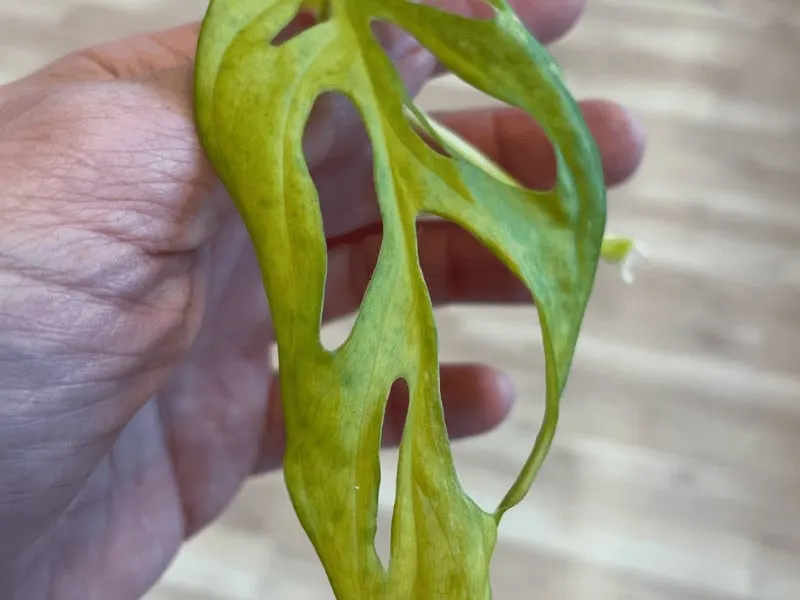
I suggest treating it with a systemic insecticide right away. The earlier you get rid of plant pests, the better. Especially thrips are very difficult to get rid of.
Here is an example of a large mealybug infestation for your reference.
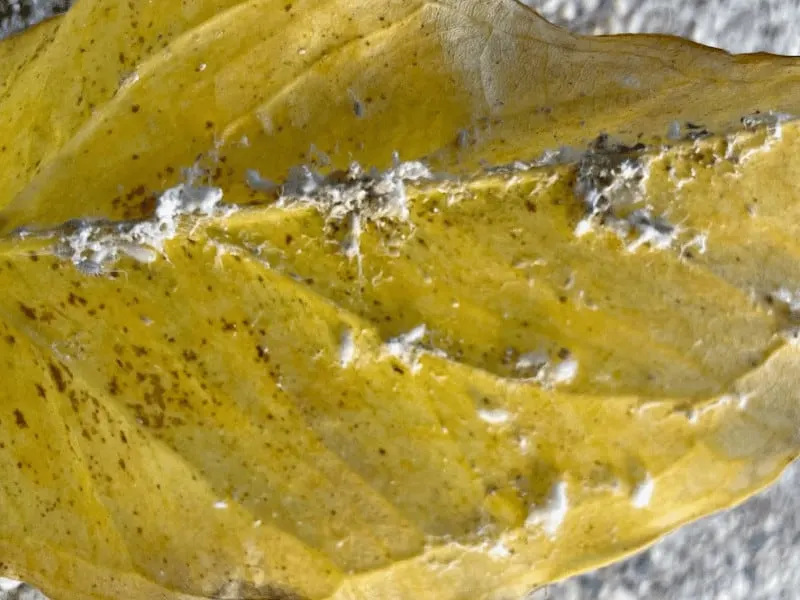
Inspect your Monstera daily and check the leaves’ underside for potential pest infestations. Alternative ways to mitigate a pest infestation include neem oil, rubbing alcohol, and diluted soap.
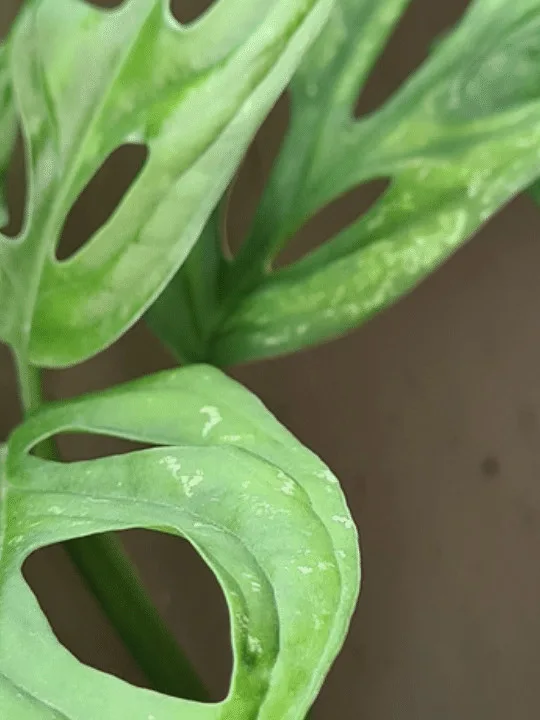
Is Monstera adansonii toxic to cats?
Monstera adansonii is toxic to cats. It contains calcium oxalate chrystals. Keep it away from pets such as cats and dogs.
Monstera adansonii is moderately toxic to cats and dogs, as is the Monstera deliciosa, according to ASPCA regarding your dog or cat.
If eaten, they can have several adverse reactions, such as vomiting, swallowing problems, or oral irritation.
If eaten, they can have several adverse reactions, such as vomiting, swallowing problems, or oral irritation.
If your pet cheats on leaves around the house, keep your Monstera plant out of its way.
Popularity
Rating: Moderately Popular
The Swiss Cheese Vine plant is not among the most popular indoor plants. Its distant relative, the Monstera deliciosa, usually outshines it.
The common name for this relative is the “Swiss Cheese Plant,” which makes it confusing compared to the “Swiss Cheese Vine Plant.” These two species are quite similar, though M. deliciosa is larger, thus taking the cake.
Where can you buy a Monstera adansonii?
This plant is not all that rare, making it easier for you to purchase from various stores.
Some websites still outsold their limited stock, so it is always best to call ahead and double-check the selected store’s inventory.
Here are a few options in terms of buying your very own Swiss Cheese Vine plant:
Amazon: Although you may not think of this website for your plant supplier, Amazon has many options. Depending on the size you want, you can expect to pay between 10 and 30 dollars.
Etsy: Another option for your Monstera shopping needs. Expect to pay around 10 dollars for a cutting or 10 to 45 dollars for a mature individual.
Ebay: Buying a plant from Ebay can be challenging, as you often compete with other contenders. Do not rule it out, however, as it is possible to make a quick purchase. Most Swiss Cheese Vine plants sell for approximately 30 dollars on this website.
The price for a Monstera adansonii ranges between $10-30.
Monstera deliciosa vs adansonii
Monstera deliciosa and Monstera adansonii are two different plants from the same genus called Monstera. The adansonii is also called the Swiss Cheese vine, whereas Monstera deliciosa is commonly called the Swiss Cheese Plant. The deliciosa produces giant leaves that fenestrate and also grow taller. Adansonii is a vining plant. The large form Monstera deliciosa is a crawler with a tight internodal space. Only Monstera deliciosa borisgiana is a vining plant.
Monstera adansonii mint
Monstera adansonii ‘Mint’ is the mint variegated version of the Swiss Cheese vine. The leaves are white with streaks of green. They cost more than the Monstera adansonii albo as they grow slower and are rarer. The mint marble is stable.
Monstera adansonii Aurea
The aurea version has yellow variegation instead of pink. It is a beautiful cultivar that is harder to get than the albo. The care is the same as for the Variegated Swiss Cheese Vine. Due to the lack of chlorophyll, they need more sunlight to thrive.
Monstera adansonii tricolor
The monstera adansonii tricolor has 3 leaf colors, green, white, and yellow. Some of the variegation will be white, whilst other leaves have yellow variegation. All the three colors are mixed on this variant.
Monstera adansonii on Instagram
With social media becoming all that more popular, certain plant species have been able to gain followers. The Swiss Cheese Vine plant is no exception.
When considering a new plant for your home, looking at a few pictures is helpful. Instagram offers you that glimpse into the future.
Commonly used hashtags for Monstera adansonii include:
• #swisscheesevine
• #swisscheesevineplant
• #monsteraadansonii
• #monsteraaddict
You may also enjoy following a few people provided below:
@thearchipelagoplant
@monsteracoplants
Having a plant that adds not only greenery but also an element of character is essential in every household. The Swiss Cheese Vine plant does just that with unique perforations.
And best of all, you can add it to a large pot or give it a stake to climb up.
Using this guide, you can successfully care for your new plant and possibly create new individuals through propagation.
Frequently Asked Questions
Is the Monstera Adansonii the same plant as the Monstera deliciosa?
The Monstera adansonii and the Monstera deliciosa belong to the Araceae family. These plants produce an inflorescence or flower called a spadix, but they are not the same plant. The Monstera adansonii produces smaller leaves and is a vining or trailing plant. The Monstera deliciosa forms much bigger leaves in its adult form, whereas the Monkey Mask produces holey leaves.
What plant is called the Swiss Cheese Plant?
The Monstera deliciosa is called the Swiss Cheese plant because of the slits and holes in its leaves. The name is derived from the Emmental cheese produced in Switzerland that has holes in it. The leaves are said to resemble this look. The Monstera Adansonii is also referred to as the Swiss Cheese Vine.
Is the Monstera Monkey Mask toxic?
The Monstera adansonii is slightly toxic and can cause burns, swellings, and vomiting in cats and dogs.
Is the Monstera adansonii easy to propagate?
The Swiss Cheese Vine is fairly easy to propagate. You can take a cutting from a stem section and put it in water, Spaghnum Moss, or soil. Within 3-4 weeks, you will see roots developing. You need to have at least one node for a new plant to grow from a cutting. Nodes are the little nubby things below where leaves branch off the stem. Cut below a node if you want to propagate a Monstera Adansonii. It is best to have 2-3 nodes and leaves on a cutting as this will increase your chances of successful propagation.
Where can I buy a Variegated Monstera adansonii?
Your best chances of buying a Monstera adansonii Variegata are NSE Tropicals if you are US-based. Other sources are Facebook plant groups, Instagram, and last but not least, eBay. Most recently, the prices have stabilized as they are now more readily available in the 3-figure range.
Is Monstera adansonii easy to care for?
Monstera Adansonii is a fairly easy plant to care for. Care is easy as long as you provide bright indirect light and use a loose soil mix. The trickiest part is a correct watering schedule, as overwatering will lead to root rot.
Is Monstera adansonii rare?
Monstera adansonii is not considered a rare plant. There are many rarer plants, such as the Monstera obliqua, but everything is getting more and more available as the supply of plants increases globally.
Can Monstera adansonii take full sun?
Monstera adansonii can only take full sun for 3-4 hours in the morning. The Swiss Cheese Plant prefers bright indirect light, as full direct sun will start to scorch its leaves after a couple of hours.
Monstera adansonii Care Conclusion
Monstera adansonii needs bright indirect light. The ideal temperature range is between 64 – 81 °F (18 to 27 °C). Keep the humidity above 60% for it to thrive. Use an aroid mix of bark, perlite, peat moss, and charcoal. Fertilize with a well-balanced fertilizer with an NPK ratio of 20-20-20 diluted to half-strength every two weeks in spring and summer and once a month in autumn and winter. Water about once a week just before the soil feels dry.
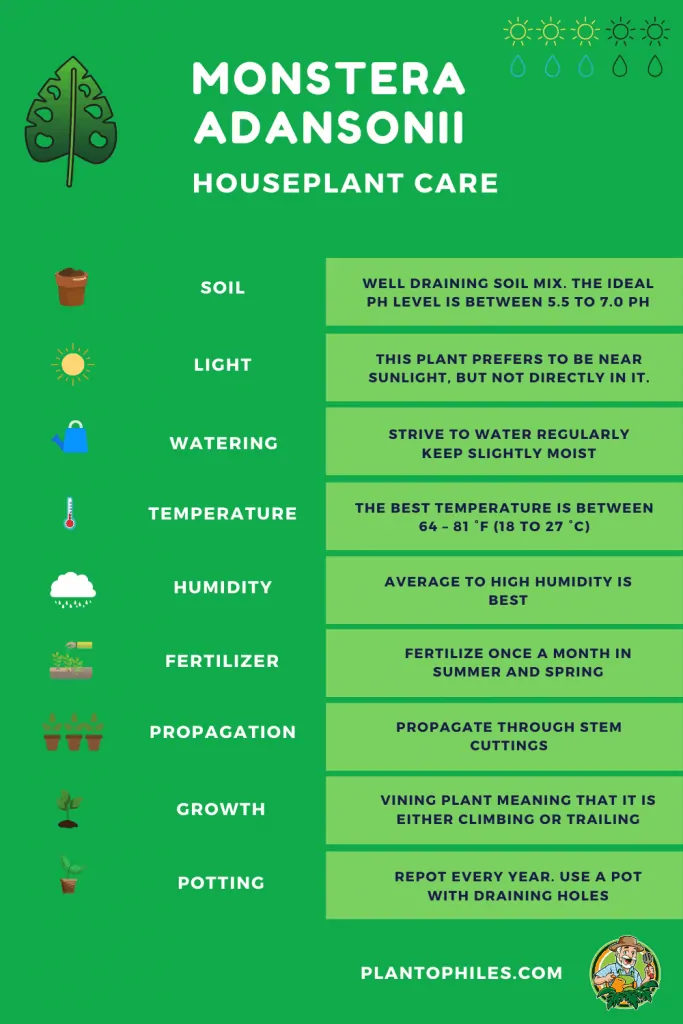

Daniel has been a plant enthusiast for over 20 years. He owns hundreds of houseplants and prepares for the chili growing seasons yearly with great anticipation. His favorite plants are plant species in the Araceae family, such as Monstera, Philodendron, and Anthurium. He also loves gardening and is growing hot peppers, tomatoes, and many more vegetables.

